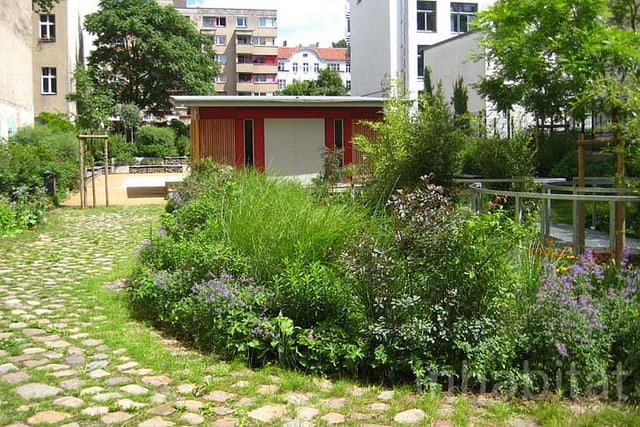A more sustainable garden is a better garden and one that can benefit you in terms of your footprint on the earth and also the amount of money in your pocket. Sustainable gardening is growing food without the use of pesticides and fertilizers that include toxic chemicals which effect our soil and water. Sustainable gardening depends mostly on compost, diversity of plants and beneficial insects to supply the soil the much needed nutrients. These methods are more sustainable for health of humans, wildlife, soil and water supply. Here are ten tips for a better, greener garden that works in harmony with nature.
According to Wikipedia,
“Sustainable gardening includes the more specific sustainable landscapes, sustainable landscape design, sustainable landscaping, sustainable landscape architecture, resulting in sustainable sites. It comprises a disparate group of horticultural interests that can share the aims and objectives associated with the international post-1980s sustainable development and sustainability programs.“
Soil Testing
There are soil test kits on the market that are simple and easy-to-use which won’t break your budget. To get one, either head online or go to your local nursery. You’ll quickly find out if your soil has a high alkaline content or is too acidic. That way, you can add your fertilizer and compost to adjust your pH. Walmart plants flourish when the pH is balanced, some plan like blueberries do better when the soil is more acidic. Use fertilizers that are seaweed based in that case Get 100% organic manure. There’s the potential for crop damage if you purchase animal manure that has traces of hormones or antibiotics.
Stick To Organic
Not only will your garden be sounder ecologically when you use fewer chemicals, it will also cost you less. It’s even more important to garden organically when you’re raising food for the family dinner table. Start by building soil that’s rich in nutrients by adding natural compost. Only use organic solutions to treat plant disease or insects in your garden. Click here to find out more about organic gardening solutions.
Landscape Mulch
Mulching does wonders for your garden. It acts as a protective barrier to keep your soil moist while preventing weeds. Mulch is especially important in regions with restrictions on watering. Around your landscape plan and in your garden beds, add two to three inches of mulch. Coir (made using the hulls of coconuts), grass clippings, pine needles, cocoa bean hulls, and shredded bark are all sustainable mulch options.
Native Plants
Native plants are indigenous to your region. They are already acclimated to the type of soil and amount of rainfall in your region so they thrive better than other perennials and generally require less water. In addition, native populations of birds and insects use them for their food and shelter.
Include Flowers
Add interest to your kitchen garden with the addition of flowers. Pink Jasmine, borage, and nasturtium make wonderful choices. It’s even possible to control your aphid population by planting sweet alyssum or yarrow that attract bugs which will take care of the problem. Once planted, they will also draw more bees to your garden which will help because of the cross-pollination. Bees positively love lavender and rosemary. You can grow your own flowers by buying callas or bearded iris bulbs for sale.
Use Less Water
Because water is restricted in areas where it is scarce, you need to plant a garden that requires less water in order to be sustainable. A method of landscaping and gardening called xeriscaping includes the use of drought tolerant perennials and shrubs. You can also place a rain barrel at your downspouts base to collect rain to use on your garden. Here are some great tips from The Guardian.
Cultivate Your Food
Many people find satisfaction in growing their own delicious herbs, vegetables, and fruits. This is a major part of the lifestyle if you want to live in a sustainable manner. Plant with the seasons and plant intensively. Keep in mind that the hot temperatures of summer are too harsh for spring crops such as lettuce and greens.
Once the lettuce and greens are done, use backspace to plant peppers, tomatoes, and other hot weather crops. Cool weather crops can be sown again once autumn arrives. The same area of your garden can deliver three seasons worth of food. According to South West Greenhouses, the average family could save hundreds of dollars a year through methods like this. So, it’s not just green, it’s also budget friendly.
Waste Water Recycling
As long as the water hasn’t been contaminated with cleaning detergent or animal fats, you can use water that’s been already used for your plant beds. That means you can’t use water from the toilet or that’s been used to do your laundry or clean the Crock-Pot. To make sure that your plants have plenty of clean water, it’s a good idea to harvest rainwater.
Seed Saving
At the end of the growing season, you can collect dried seed heads from annual flowers and store them all winter in a dry space. Next spring, use these seeds to replenish your garden with vibrant colours. Morning glory seeds, sunflower seeds, and marigolds are easy to gather.
Compost Use
When you compost your green waste, you are on your way to a sustainable garden that you’ll truly enjoy. By using a compost pile, you can turn dried leaves, deadheaded flowers, and grass clippings into nutrient-rich soil.
Lawn Care
When mowing your lawn, you need to mow high. The more the ground is shaded with grass, the soil will not dry out too quickly. This will help to keep some of the weeds from growing. A manual lawnmower will do best in this situation.
If you plan to use the garden at all times, it is best to set-up a solar panel device. This will help you run any power tools or light up your garden at night. Also, an inexpensive solar set-up will reduce your energy bills even if you want to operate an electric lawnmower. It is also environmentally friendly on the other hand. In fact, you will not have to use gasoline to operate the garden tools under such circumstances.
Building Up Organic Matter
Organic matter such as animal manure, compost, and minerals are essential to feed the microbial mass of the soil which consists of fungi and bacteria. In fact, the fungi and bacteria will do a great job compared to synthetic garden fertilizers.
Planting Native Species
Native plants are indigenous to the particular region where they grow. Hence, they are quite resistant to bad weather, disease and poor soil in that particular region. On the other hand, native plants are important to offer shelter and food to the birds and insects in the area.
Managing Weeds
Planting small shrubs or ground covers will shade the soil from sunlight. This will reduce the growth of weeds. Mulching the ground with stones and wood chips also has a similar effect. Larger areas should be covered with black plastic sheets. Even though the weeds may germinate, they will eventually die because there is no sunlight. Covering with the plastic sheet for two weeks is enough to kill the weeds.
Planting Perennials
Perennials would regrow better with each season. They are one of the best ways to get value for your money. These plants can be easily divided giving more plants to spread across the garden.






